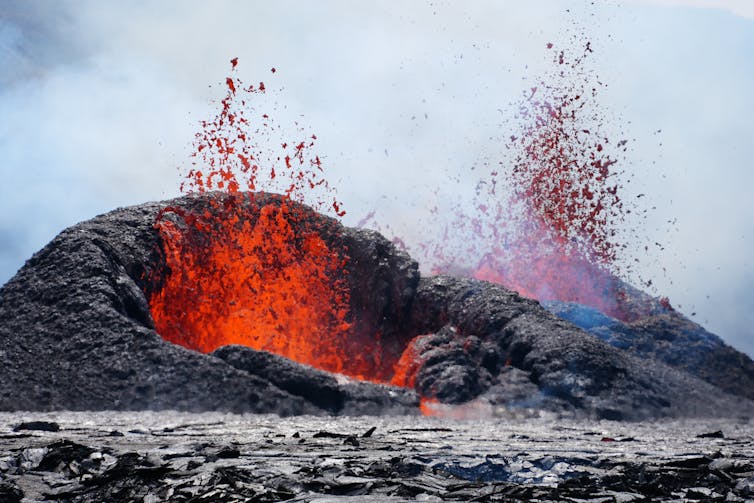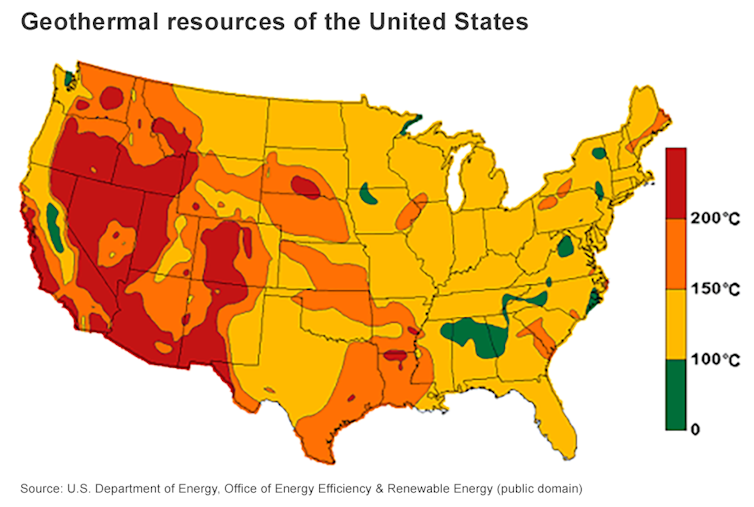
During an eruption in September 2023, lava splashes out of a vent on Kilauea in Hawaii.
M. Patrick, USGS, via NPS, CC BY-ND
David Kitchen, University of Richmond

Curious Kids is a show for kids of all ages. If you have a question you’d like an expert to answer, send it to [email protected].
Could we use volcanoes to generate electricity? – Lawrence, age 7, Dublin, California
Converting glowing lava from an active volcano into electricity would be dangerous and unreliable. Volcanoes don’t erupt on predictable schedules, and lava cools too quickly. However, many countries, including the United States, have found ways to use volcanic heat to generate electricity.
Geothermal energy is obtained from heat generated by natural processes deep within the Earth. In most areas, this heat only warms rocks and groundwater near the surface. In volcanically active regions, however, the heat is much more intense. Sometimes it melts rocks and forms magma.
Volcanoes act like giant heat sources, pushing magma closer to the Earth’s surface. Some of this molten rock may erupt, but much of it stays underground, heating the surrounding rock and water. Where heated water rises to the surface, hot springs and geysers form, which can last for thousands of years.
To use this energy to generate electricity, engineers look for areas where magma is close to the surface and drill deep wells down to the heated rocks and water. These wells bring steam to the surface, where it is piped into a power plant to turn turbines and generate electricity.
After the steam has produced electricity, it cools and condenses back into hot water. The water can be used to convert another liquid with a much lower boiling point, such as butane, to power a second generator. It is then pumped back underground to be reheated.
The earth is constantly producing heat, so geothermal energy is a renewable resource. And geothermal power plants produce far less pollution, waste and greenhouse gas emissions that warm the earth’s climate than burning coal, gas, oil or using nuclear energy.
Geothermal energy sources can be available for decades or even longer. Unlike other renewable energy sources such as solar and wind energy, geothermal energy is available 24 hours a day, 365 days a year.
The world’s geothermal hotspots
Geothermal energy is already used in many places around the world, especially in regions with strong volcanic activity. Iceland’s electricity, for example, is generated almost entirely from renewable sources, with geothermal energy providing around 25% of this. The country is located on many active volcanoes, making it an ideal location for geothermal power plants.
Some U.S. states, including California and Nevada, have geothermal power plants thanks to their volcanic regions. Other active geothermal sites, such as Yellowstone National Park in Wyoming, are protected from development.

USEIA
Challenges for geothermal energy
Why isn’t geothermal energy used as widely as wind or solar energy? First, geothermal power plants must be built near volcanoes or other places where it’s unusually hot beneath the surface. These resources aren’t always located near big cities or industries that use a lot of electricity.
Second, drilling deep wells and building power plants can be costly. However, the long-term benefits of geothermal energy often outweigh the initial costs.
Third, in some cases, drilling and pumping water under pressure can trigger small earthquakes. Scientists and engineers are working to predict and manage this effect.
Despite these challenges, harnessing the earth’s natural heat can create a renewable, reliable and clean source of energy. As technology advances, more and more places around the world will turn to geothermal energy to light people’s lives. Volcanoes are reminiscent of a large power station deep underground, waiting to be used.
Hey, curious kids! Do you have a question you’d like an expert to answer? Ask an adult to send your question to [email protected]. Please tell us your name, age and the city you live in.
And since curiosity knows no age limit, adults can join in too. Let us know what interests you. We can’t answer every question, but we’ll do our best.![]()
David Kitchen, Associate Professor of Geology, University of Richmond
This article is republished from The Conversation under a Creative Commons license. Read the original article.
